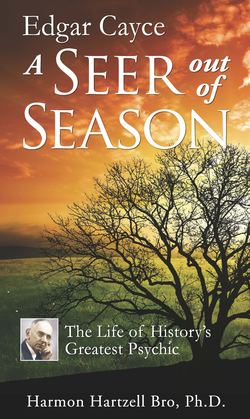Читать книгу Edgar Cayce A Seer Out of Season - Harmon Hartzell Bro - Страница 10
На сайте Литреса книга снята с продажи.
CHAPTER 1 I Don’t Do Anything You Can’t Do
ОглавлениеThere was literally a loaded gun on my hip when I began a journey into the scarcely believable life of Edgar Cayce. It was wartime in the mild June of 1943, and I was a graduate student at the University of Chicago, holding a night job as a civilian guard under military command. Between my rounds through the laboratories in a large wooden building (given a deceptive exterior to mislead saboteurs or spies), I perched on a stool under a naked light bulb and read chapters from a biography published the year before, There Is a River: The Story of Edgar Cayce.1 Now and again I glanced around and fingered my gun when there were creaking sounds in the woodwork or the dogs barked hoarsely in the animal lab down the hall. There was real danger from enemy agents, according to the supervising Army captain. Recent break-ins had threatened research secrets and cost the life of one guard. Often I wondered, while trudging hourly routes through the night, whether I would hesitate for a critical second before firing to kill a man who sprang from behind a table of chemical retorts or around the great humming transformers.
Such images of violence, making all too real the daily reports of GIs meeting sudden death on European and Pacific battle fronts, were utterly incongruous with the images in the book before me. There the author, Thomas Sugrue, a respected editor and critic for the Saturday Review of Literature, described how an elderly ex-photographer in the oceanfront resort of Virginia Beach, Virginia, regularly entered a quietly creative state so potent that it mocked all the university technology surrounding me. The gun on my hip and the book on my knees represented radically different approaches to power. One stood for the skilled violence we guarded in an advanced and top-secret weapons research project. The other reported valuable knowledge about a staggering array of targets, reached peacefully and swiftly in a calm trance state.
Had I known the full nature of the research in my care, the contrast with Cayce would have been even more stark. The intricate equipment was part of the Manhattan District or Manhattan Project of the U.S. Army Corps of Engineers. Of course, we guards tried discreetly to learn what was happening in our cluster of buildings across the rolling, grassy Midway from the main campus. We could not puzzle it out, because some rooms with flasks and bubbling tubes were clearly for chemical research, while others were crowded with electrical apparatus that suggested work in physics. And why did we have live animals, such as dogs, monkeys, and rats? What was the connection between living flesh and the technology we suspected was connected to the university’s atomic accelerator across the campus? When I tried to question my friend and neighbor from boyhood, the distinguished physicist Arthur Compton, I got only pleasant generalities.
The well-hidden truth of the Project was known in 1943 only to a score or so of scientists such as Robert Oppenheimer (working at the level of Compton and his Chicago colleagues under Enrico Fermi), selected military chiefs, and President Roosevelt plus a few advisors. Just a few blocks from where I was reading through the night about Cayce, a team of researchers in quarters created under the west stadium grandstands of Stagg Field had achieved the first controlled atomic reaction, which they were now turning into an atom bomb. At the end of the same football field, where I had so often flung my javelin towards the sky and watched its distant puncture of the soft earth, they had created a new weapon that would make even warships and tanks seem as archaic as javelins. Just months ago, in the cold and blowy Chicago December, they had turned loose a power which in two years would create an agony of screaming in Japan—enough to drown out all the throaty roars of Saturday football fans that I had heard throughout my youth near Stagg Field. In the very playground of the University, these gifted scientists had fashioned an instrument to suddenly kill some ninety thousand human beings at Hiroshima, with an equal number maimed. Nobody would ever know the exact casualties there and at Nagasaki, because so many civilians would be vaporized and incinerated in the August days already destined at our gracious campus.
